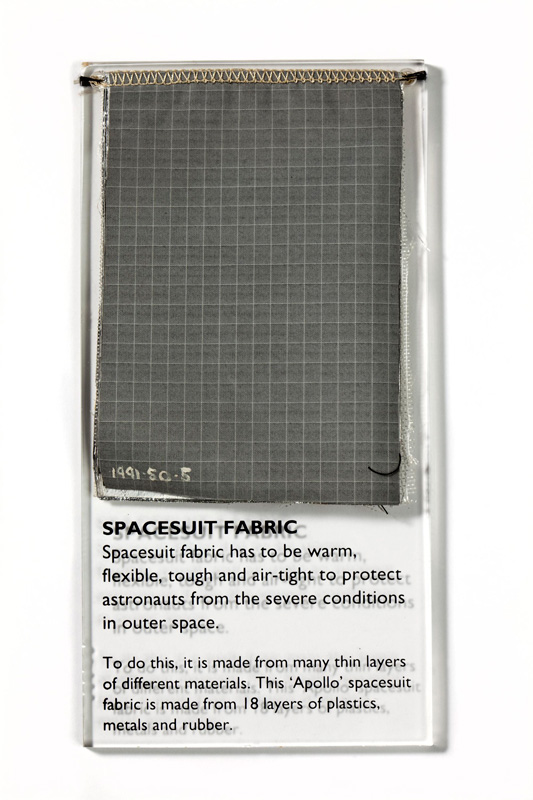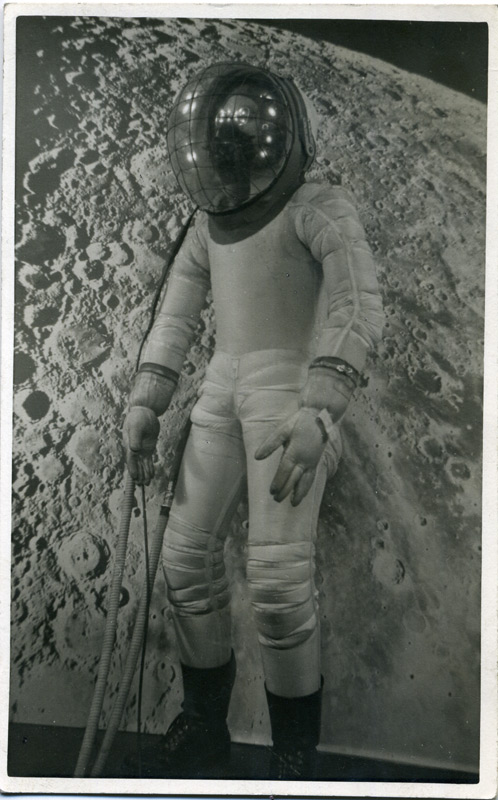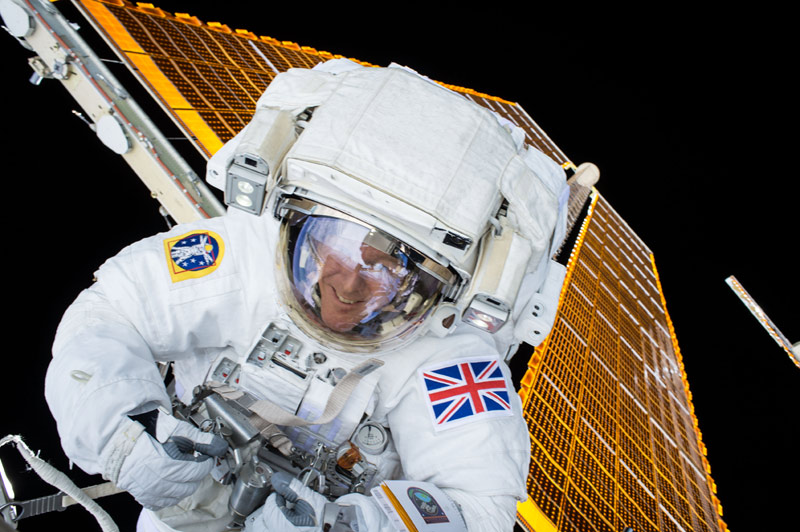On 10 March, we will be launching (pun intended) our display of the Soyuz capsule that brought astronauts Tim Peake, Yuri Malenchenko, and Tim Kopra back to Earth in June 2016. We are the fourth museum to host the capsule in its eight-stop tour, and I’ve been working to find a link between our collections and the Soyuz capsule to give our display a uniquely Manchester flavour.
Luckily, we have a wealth of objects and archives that relate to space here at the Museum. For instance, I was incredibly pleased to find we have in our collections a sample of Apollo Space Suit fabric; the same kind that Neil Armstrong, Buzz Aldrin and Michael Collins wore when they made their historic mission to the moon in 1969.

© Museum of Science and Industry, Manchester / SSPL. Creative Commons BY-NC-SA
Perhaps even more amazing, though, is that we also have archives of a company based right here in Manchester that was making space suits a full 10 years before Armstrong made his first steps on the moon. This company was P. Frankenstein and Sons Ltd, and it opened in Manchester as a manufacturer of experimental rubberised fabrics in 1854.
By the 1950s one of its major products were flight safety suits for pilots. They were called ‘full pressure suits’, and were designed to keep pilots safe in case of aircraft failures at high altitudes. In the event of decompression of the cabin, the suits would inflate and keep the pressure steady on the pilot’s body, helping them to breathe without blacking out.
The suits also had thermal cables embedded within them to keep pilots warm, and flotation devices in case of a water landing. These designs allowed pilots to stay safe at increasingly high altitudes. It’s no wonder then that soon, Frankenstein set their sights even higher, trying designs that could keep people alive in space.

Image courtesy of P. Frankenstein and Sons Ltd
Of course, Frankenstein and Sons were not the only ones shooting for space. John F. Kennedy’s vow in 1961 to put an American on the moon by the end of the decade had spurred a need for rapid advances in technology, such as space suits. Perhaps it is because of this that NASA approached Frankenstein and Sons to help them design the first Apollo space suits.

© NASA
Though our archives lack detail on how exactly Frankenstein worked with NASA, we have the testimonies from ex-Frankenstein and Sons employees who the Museum interviewed back in 2007. According to one former employee, John Dowling, the company had little direct contact with NASA, but they did sell them a measuring machine and some ‘neck suits.’ The neck suits were flotation devices to keep a person’s head above water, and the measuring machine was to help design suits with greater mobility.
His colleague, Fred Evans, added that originally the NASA suits had poor mobility, but Frankenstein had developed a machine to allow precise measurements to be taken of their potential astronauts. Using these measurements, they were able to create suits that allowed their wearers to reach all the way behind their heads. Evans says that the NASA suit wearers, by comparison, couldn’t raise their arms above their shoulders.
Furthermore, they say that one of Frankenstein’s engineers, Ian Wright (pictured above in a full pressure suit), was invited over to NASA for a couple of months to help them with the mobility issue. Finally, Cliff Butterworth, who developed a cooling system for the full pressure suit, says two NASA employees visited the Frankenstein and Sons factory, and he was asked to take them through the engineering that made up a full pressure suit.
They then took one of Frankenstein’s full pressure suits with them back to the US, and a further two suits were reportedly sent to them later on. So, while we can’t identify for certain what innovations NASA borrowed from Frankenstein, we know there was substantial contact and sharing of ideas.
Amazingly, the story of Frankenstein and sons was all but forgotten until 2007, when Museum staff uncovered it while looking through our archives. Staff at the time quickly set out to contact the people who had worked for Frankenstein and Sons during this time, and put together an oral history interview. Thanks to the work of museum staff, we have direct stories from employees about their working lives, and about this incredible connection between Manchester and space.
Ultimately, Frankenstein was unable to put a Mancunian on the moon themselves, but their legacy lives on in modern suits, just like the ones that Tim Peake wore on his mission to the International Space Station. He wore his Sokol (Falcon) Suit on the journeys to and from space. It was designed to protect him if there were any problems while he was traveling. When he did his space walk outside the International Space Station, he wore his extra-vehicular mobility (EMU) suit. An EMU suit is like a personal spaceship that provides everything an astronaut needs to survive space for a short time.

©ESA Stephane Covaja

©NASA
These modern spacesuits are the culmination of decades of research that trace back to the work of companies like Frankenstein and Sons. That is why for the Manchester leg of the Soyuz tour, we will be telling the story of space suits, and in particular the role that P. Frankenstein and Sons Ltd played in helping mankind reach new heights of exploration. Our display features images of Frankenstein and Sons from the archives, and we’re incredibly pleased to be able to present this story to our visitors.
If you would like to book a visit to our archives to see the Frankenstein and Sons material for yourself, please contact collections@scienceandindustrymuseum.org.uk.
Após a Soyuz, veio a MOS (Moon Orbital Spaceship). Depois veio a versão UNION-T da Soyuz entre 1969 e 1971 e o compartimento orbital do programa “Soyuz – Apollo” entre 1971 e 1975.
I was a member of the 1967 British Speleology Association expedition to the Gouffere Berger in France. I wore a dry suit made for us by Frankenstein when we established the the world depth record for a natural cave.
I still have the suit but I have not touched it for years.
It was my father, Joseph Silverston, MD of P Frankenstein & Sons Ltd of Newton Heath, Manchester, who was the driving force behind all the develovment of new materials for use in space travel, anti-G pilot suits, submarine escape suits, etc. Early in WW2 he developed automatically inflating life jackets for air crew ditching in the sea. These were designed to turn sn unconscious person face upwards. My father opened a new factory, Beaufort Air/Sea Rescue, specialising in life jackets, life rafts, etc was later opened in Birkenhead. My father died in 1968 in Los Angeles, California.
Hi I work at a company called Survitec who took over from RFD Beaufort based in Birkenhead some time ago, prior to this our Birkenhead site was known as Frankenstien & Sons, I have always been intrigued by the NASA connection with the spacesuit developments and am trying to find some information on an Engineer named Jim Hawkin who I believe received an MBE for his work in this field and was sent a plaque from NASA which frustratingly I cannot find. we still have a couple of employees who knew Jim who has sadly passed away now. I am wondering if you could shed any light on this subject, Kindest regards, Terry
My dad was Matthew Radnofsky, who designed high flight suits then spacesuits at NACA/NASA; I have some letters and photos from your father when they worked together after the war. When I was a little girl, I remember your father visited us in Texas a few times; we took him to San Jacinto and he bought me a lucky coin at the battleship and monument. I remember how highly my dad spoke of your father for decades, and what fun they had creating things. I’d be happy to send you copies of their correspondence, if you like.
My mother, Violet, worked on the manufacture of these suits at Newton Heath and later in Chadderton. I understand that it was very, very heavy work!
I was Finance Director at Beaufort frim 1977 to 1980 and still have happy memories. Together with a subsidiary factory in Llanberis there were 100s of employees. The company was a very successful part of BTR Industries and later became part of the Invensys group.